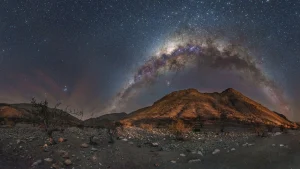Graduated in UNAB Civil Engineering, she decided to make astrophotography not only her passion but also her way of contributing to the world. Today, after years of development in this discipline, she can proudly say that she is the author of an “Astronomy Picture of the Day”, according to the records of the largest space agency on the planet. She though she wants to go for more.
Sonia Tamayo, UNAB Journalist.- when four years ago Carina Letelier, graduate Industrial Civil Engineering and Master in Engineering Sciences mention Logistics and Operations Management UNAB left the company where he worked to make the astrophotography his passion in life, he never suspected that he would enter the history of NASA and of that discipline in particular, in which he has been able to perfectly combine his motivation to explore the skies with the sense of planning acquired in his student days in the Faculty of Engineering.
A snapshot that he took of a star, while looking for the northern lights in the Arctic Circle, in Iceland -and whose title is Aurora Over Arctic Henge-, earned her being, on March 27, the first Chilean and Latin American woman, and one of the few in the world, to have her work published as NASA Astronomy Picture of the Day. Today, he can say with satisfaction that that great step taken to change his course and look towards the skies of the world was worth it.
 What do you value most about this recognition?
What do you value most about this recognition?
Apart from being the first Chilean and Latin American to publish “the photo of the day” in the NASA archives, it is knowing that this image that I took, after much effort and planning, will remain forever recorded there, and that this record will also serve so that many other people who perhaps think that they will never change or leave their comfort zone to pursue goals as challenging as this one, are encouraged to do so too. And I say that because I really think that we can all be star hunters.
It is a great achievement, without a doubt. But how was the origin of the path that led you to that?
One day I realized that I wanted to do something different with my life. At the same time, almost by chance I came across an SLR camera that I had lying around, and I wanted to give it some use. Added to that was the fact that on the news they said there would be a meteor shower, so without giving it much thought I went to Cajón del Maipo to take photos. And although that time I went, and the times after, I didn’t take anything good, I was interested in learning. And so I was doing it, in a self-taught way. First about the positions and colors of the stars, then about the use of cameras. And, meanwhile, the desire to transcend and to do something different, great, arose more and more in me.
Was it in those moments when you left the company where you worked?
No, before I left I had also started to give workshops in which I did well and which, for the same reason, made me believe that I could dedicate myself to this permanently, and that I should continue studying, although I also knew that it had a foundation. delivered by Engineering at UNAB, both in undergraduate and in the master’s degree, which was also going to help me.



Of all the bases or tools provided by UNAB, which ones have helped you to develop what you do today?
What I learned when I studied at Campus República, about project planning, planning, budgeting or marketing, was very important because without it I would not have had the tools to create a brand, sell a company or develop new plans that would lead me to continue. with this passion, but at the same time allow me to live from it.
Already received recognition from NASA, you must now have new challenges on the horizon, or in the stars, rather.
If many. I would like to get to the cover of NatGeo with a project or work with them, or develop documentaries for Netflix. Always thinking of dissemination as a means to contribute to society and, at all times, putting into perspective how small we are in the Universe.
















